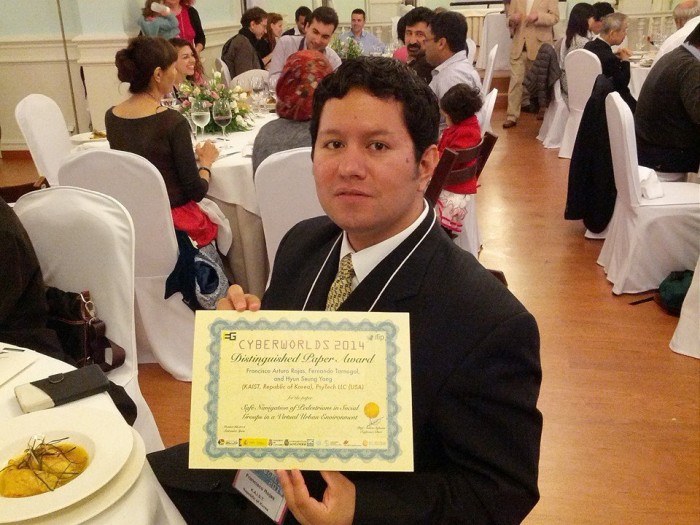
Directions
Francisco Rojas, PhD student, received the Distinguished Paper Award and is a Stakeholder in Crowd Funding Campaign
2014-10-16

KAIST Computer Science Ph.D. Student Francisco Arturo Rojas (http://mind.kaist.ac.kr/Francis) (age 32) who is advised by Professor Hyun S. Yang (http://mind.kaist.ac.kr/professor.php) since the spring of 2010 received the Distinguished Paper Award at the international CyberWorlds 2014 (http://www.cw2014.unican.es) conference which took place at the royal Magdalena Palace in Santander, Spain in October 6-8. He presented two full papers, and the paper that won the award was titled “Safe Navigation of Pedestrians in Social Groups in a Virtual Urban Environment”, which was additionally co-authored by the founder of PsyTech LLC (http://psychologicaltechnologies.com), Fernando Tarnogol, a licensed psychologist who with a hired team of developers created the city virtual environment with vehicular traffic for which the crowd simulation research work was applied. The crowd simulation featured in this paper is the most up-to-date extension of ongoing two-year research work at the Artificial Intelligence and Media Lab (http://mind.kaist.ac.kr/crowdsimulation.php) of KAIST in making non-playable virtual characters mimic how real people move together in real life in social formations, with previous versions published at conferences such as Computer Graphics International (CGI 2014) (http://rp-www.cs.usyd.edu.au/∼cgi14/program/papersessions.php) in Sydney, Virtual Reality Continuum and Its Applications in Industry (ACM SIGGRAPH VRCAI 2013) (http://www2.mae.cuhk.edu.hk/∼vrcai2013/program.html) in Hong Kong, and Computer Animation and Social Agents (CASA 2013) (http://www.cs.bilkent.edu.tr/∼casa2013/?p=schedulespeakers) in Istanbul. The crowd simulation realism results were positively evaluated by many individuals via the original Oculus Rift headset for developers.
Furthermore, the virtual reality application itself for which the research is applied, called PHOBOS (http://phobos.psychologicaltechnologies.com), is actually meant to be a professional exposure therapy tool to be used by doctors for the treatment of many patients’ common phobias and anxiety disorders, such as fear of heights, flying, public speaking, being confined in closed or small spaces, crowds, and spiders, among others. Since October 7 there has been a crowd funding campaign by PsyTech LLC at INDIEGOGO
(https://www.indiegogo.com/projects/phobos-anxiety-management-vr-platform) in order to continue development of the product which is currently in its early stages. So far the campaign has generated over $1300 for which Francisco himself is actually a stakeholder given his major research contribution to the project. The funding campaign will close on November 25 this year.










